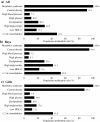Association between obesity and metabolic co-morbidities among children and adolescents in South Korea based on national data
- PMID: 24666605
- PMCID: PMC3976357
- DOI: 10.1186/1471-2458-14-279
Association between obesity and metabolic co-morbidities among children and adolescents in South Korea based on national data
Abstract
Background: Childhood obesity has become a serious public health threat worldwide due to its many short- and long-term adverse health effects. We assessed the association between weight status and metabolic co-morbidities among South Korean children using nationally representative data.
Methods: Data from the 2007-2008 Korea National Health and Nutrition Examination Surveys for 1,526 children aged 10-19 years were used. Logistic regression models were fit to examine the association between weight status [overweight, 85th percentile≤BMI<95th percentile; obese, BMI≥95th percentile; and central obesity, waist circumference≥90th percentile, based on 2007 Korean National Growth Charts] and metabolic outcomes.
Results: More obese children had metabolic co-morbidities than normal-weight children (P<0.05). Boys had higher means BMI than girls, WC, and BP, while girls had higher means of total blood cholesterol and HDL-cholesterol (P<0.05). Attributable risk of metabolic syndrome was high due to overweight and obesity: 91.1% for central obesity and 29.6% for high TG. Obese children had increased risk of having high BP (adjusted odds ratio (OR): 1.90; 95% CI: 1.05-3.45), dyslipidemia (OR: 6.21; 95% CI: 3.59-10.75), high TG (OR: 6.87; 95% CI: 4.05-11.64), low HDL (OR: 4.46; 95% CI: 2.23-8.89), and ≥2 co-morbidities (OR: 26.97; 95% CI: 14.95-48.65) compared to normal-weight subjects, while the associations between weight status and metabolic outcomes were stronger in boys.
Conclusions: Obesity was strongly associated with metabolic co-morbidities in South Korean children.
Figures

Similar articles
-
Metabolic risk factors in Korean adolescents with severe obesity: Results from the Korea National Health and Nutrition Examination Surveys (K-NHANES) 2007-2014.Diabetes Res Clin Pract. 2018 Apr;138:169-176. doi: 10.1016/j.diabres.2018.01.030. Epub 2018 Feb 8. Diabetes Res Clin Pract. 2018. PMID: 29427699 Free PMC article.
-
Usefulness of the Waist Circumference-to-Height Ratio in Screening for Obesity and Metabolic Syndrome among Korean Children and Adolescents: Korea National Health and Nutrition Examination Survey, 2010-2014.Nutrients. 2017 Mar 10;9(3):256. doi: 10.3390/nu9030256. Nutrients. 2017. PMID: 28287410 Free PMC article.
-
Metabolic syndrome in childhood: association with birth weight, maternal obesity, and gestational diabetes mellitus.Pediatrics. 2005 Mar;115(3):e290-6. doi: 10.1542/peds.2004-1808. Pediatrics. 2005. PMID: 15741354
-
The emergence of cardiometabolic disease risk in Chinese children and adults: consequences of changes in diet, physical activity and obesity.Obes Rev. 2014 Jan;15 Suppl 1(0 1):49-59. doi: 10.1111/obr.12123. Obes Rev. 2014. PMID: 24341758 Free PMC article. Review.
-
Secular Trends in Pediatric Overweight and Obesity in Korea.J Obes Metab Syndr. 2020 Mar 30;29(1):12-17. doi: 10.7570/jomes20002. J Obes Metab Syndr. 2020. PMID: 32188238 Free PMC article. Review.
Cited by
-
Prevalence of Metabolic Syndrome and Impaired Glucose Metabolism among 10- to 17-Year-Old Overweight and Obese Lithuanian Children and Adolescents.Obes Facts. 2021;14(3):271-282. doi: 10.1159/000514720. Epub 2021 May 5. Obes Facts. 2021. PMID: 33951670 Free PMC article.
-
Macronutrients modified dietary intervention in the management of overweight/obese children and adolescents: a systematic review.Clin Exp Pediatr. 2024 Apr;67(4):191-200. doi: 10.3345/cep.2023.00262. Epub 2023 Jul 11. Clin Exp Pediatr. 2024. PMID: 37448128 Free PMC article.
-
Longitudinal Effects of Body Mass Index and Self-Esteem on Adjustment From Early to Late Adolescence: A Latent Growth Model.J Nurs Res. 2019 Feb;27(1):1-7. doi: 10.1097/jnr.0000000000000266. J Nurs Res. 2019. PMID: 29877910 Free PMC article.
-
Epidemiology of Childhood Obesity in Korea.Endocrinol Metab (Seoul). 2016 Dec;31(4):510-518. doi: 10.3803/EnM.2016.31.4.510. Epub 2016 Nov 3. Endocrinol Metab (Seoul). 2016. PMID: 27834078 Free PMC article. Review.
-
The triglyceride-to-high density lipoprotein cholesterol ratio in overweight Korean children and adolescents.Ann Pediatr Endocrinol Metab. 2017 Sep;22(3):158-163. doi: 10.6065/apem.2017.22.3.158. Epub 2017 Sep 28. Ann Pediatr Endocrinol Metab. 2017. PMID: 29025201 Free PMC article.
References
-
- Korean Centers for Disease Control and Prevention. National health statistics in 2011 based on the Fifth Korea National Health and Nutrition Examination Survey (KNHANES V), 2011. Seoul: Korean Centers for Disease Control and Prevention; 2012.
-
- Korean Centers for Disease Control and Prevention. National health statistics in 2008 based on the Fourth Korea National Health and Nutrition Examination Survey (KNHANES IV), 2008. Seoul: Korean Centers for Disease Control and Prevention; 2010.
Publication types
MeSH terms
Substances
Grants and funding
LinkOut - more resources
Full Text Sources
Other Literature Sources
Medical
Miscellaneous

